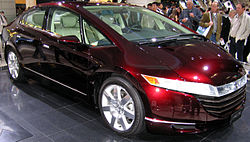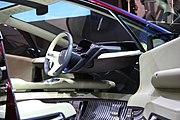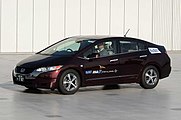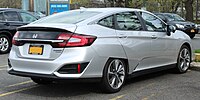Honda FCX
| Honda FCX | |
|---|---|
| Production period: | since 1999 |
| Class : |
Compact class (1999 + 2005) Small car (1999-2005) Middle class (from 2007) |
| Body versions : | Limousine , station wagon |
The Japanese company Honda has been developing and selling a range of fuel cell vehicles under the name Honda FCX since 1990 . From 1999 to 2001 four different versions of the FCX based on the Honda EV were presented. A small series of improved fuel cells was then launched, which from 2003 to 2006 were leased to various government organizations and companies as well as two private individuals in California and Japan.
With the FCX Concept 2005 , Honda presented a vehicle specially designed for the fuel cell, which, with the FCX Clarity presented in 2007, was ready for small series production and could be leased in the USA and Japan from 2008.
In 2015, Honda presented the Clarity Fuel Cell, a drive-train improved successor model that has also been sold as a plug-in hybrid and electric car since autumn 2017 .
FCX
| FCX | |
|---|---|
|
Version 2005 (leased from Idemitsu) |
|
| Production period: | 1999-2005 |
| Body versions : | Station wagon |
| Engines: |
Electric motors : 49–95 kW |
| Length: | 4165 mm |
| Width: | 1760 mm |
| Height: | 1645 mm |
| Wheelbase : | 2530 mm |
| Empty weight : | 1620 kg |
The FCX was a two-door, four-seater small car based on an earlier, battery-operated electric vehicle, the Honda EV plus. Since 2000, gaseous hydrogen has served as fuel , which in version 3 was stored in pressure vessels at a pressure of 250 bar and in all subsequent versions at a pressure of 350 bar. With the last versions a range of 430 km could be achieved.
While earlier versions of the FCX used fuel cell units from Ballard Power Systems , later versions were developed by Honda. As a special technical feature, these PEMFC had pressed metal bipolar plates instead of the usual carbon structures. The use of aromatic membranes also enabled cold starts down to −20 ° C.
Instead of the usual accumulator , the Honda FCX used a high-performance capacitor unit (" supercaps ") behind the back seat as temporary storage .
The following table shows the data for the various FCX versions:
| version | year | fuel | Fuel cell manufacturer |
Fuel cell performance |
Engine power |
|---|---|---|---|---|---|
| V1 | 1999 | hydrogen | Ballard | 60 kW | 49 kW |
| V2 | 1999 | Methanol | Honda | 60 kW | 49 kW |
| V3 a | 2000 | hydrogen | Ballard | 75 kW | 60 kW |
| V3 b | 2000 | hydrogen | Honda | 70 kW | 60 kW |
| V4 | 2001 | hydrogen | Ballard | 78 kW | 60 kW |
| Small series a | 2002-2004 | hydrogen | Ballard | 78 kW | 60 kW |
| Small series b | 2004-2005 | hydrogen | Honda | 86 kW | 95 kW |
In order to gain valuable practical experience for the development of fuel cell drive technology , Honda offered selected companies, cities and government organizations the opportunity to lease FCX vehicles. These were the companies Iwatani and Idemitsu in Japan, the cities of Los Angeles , San Francisco , Chula Vista , Las Vegas in the USA, the Japanese Ministry of the Environment, SCAQMD in California and the Hokkaido prefecture in Japan. In June 2005, the FCX was also offered to private customers for the first time for a leasing rate of US $ 500 per month. The first private vehicle was delivered to Redondo Beach, California .
FCX concept
| FCX Concept | |
|---|---|
| Production period: | 1999 |
| Body versions : | limousine |
| Engines: |
Electric motor : 49 kW |
| Length: | 4525 mm |
| Width: | 1800 mm |
| Height: | 1500 mm |
| Wheelbase : | 2815 mm |
| Empty weight : | |
In November 1999, Honda presented its first fuel cell vehicle at the Tokyo Motor Show . Methanol served as fuel . The fuel cell and the reformer were developed by Honda itself.
FCX Concept 2005
| FCX Concept 2005 | |
|---|---|
| Production period: | since 2005 |
| Body versions : | limousine |
| Engines: |
Electric motor : 150 kW |
| Length: | 4470 mm |
| Width: | 1865 mm |
| Height: | 1485 mm |
| Wheelbase : | 2900 mm |
| Empty weight : | |
Honda presented the FCX Concept 2005 at the Tokyo Motor Show 2005. This vehicle was also shown at the Detroit Auto Show in spring 2006. This concept study was to be produced in series within three to four years with minor conceptual changes. It is a four-door and four-seater notchback sedan with an extreme cab-forward design. Since no existing vehicle has been modified for fuel cell use, but has been developed from scratch, there are some technical features:
- The front axle is driven by a 100 kW electric motor with differential, but the rear axle is driven by 2 wheel hub motors each having an output of 25 kW
- Accommodation of the fuel cell unit in the center tunnel
- Compressed gas hydrogen tank in the rear, 178 liters with 350 bar for a range according to Honda calculations of 560 km
- Air intake via opening on the left rear (next to the bumper)
- Battery voltage of the lithium-ion battery: 300 V.
FCX Clarity
| FCX Clarity | |
|---|---|
|
Honda FCX Fuel Cell Clarity, |
|
| Production period: | 2007-2014 |
| Body versions : | limousine |
| Engines: |
Electric motor : 100 kW |
| Length: | 4830 mm |
| Width: | 1850 mm |
| Height: | 1470 mm |
| Wheelbase : | 2800 mm |
| Empty weight : | 1625 kg |
In November 2007, Honda showed the production version at the Los Angeles International Auto Show. Series production started in June 2008. Production takes place in the former NSX plant in Utsunomiya.
The series version differs from the FCX Concept 2005 in the following points:
- Body less futuristic
- Lithium-ion accumulator instead of high-performance capacitors
- Front engine with 100 kW instead of the three-engine concept
From a standing start, the Clarity reaches 100 km / h within 9 seconds. Its top speed is given as 161 km / h. The maximum torque is 256 Nm at 0-3056 min -1 .
Initially, the Clarity was offered at a monthly leasing rate of US $ 600 (about 400 EUR) exclusively in California and the plan was to produce about 200 vehicles by 2011; less than 100 vehicles are said to have been built.
Clarity
| Clarity Fuel Cell | |
|---|---|
|
Honda Clarity Fuel Cell (since 2016) |
|
| Production period: | since 2016 |
| Body versions : | limousine |
| Engines: |
Otto engine : 1.5 liters (77 kW) + electric motor : 135 kW Electric motor : 120–130 kW |
| Length: | 4895 mm |
| Width: | 1875 mm |
| Height: | 1475 mm |
| Wheelbase : | 2750 mm |
| Empty weight : | 1875 kg |
After the previous model was taken off the market in 2014, Honda presented the successor model Clarity Fuel Cell at the 44th Tokyo Motor Show in October 2015 . The vehicle is the world's first series model of a sedan in which the entire drive train with fuel cell is completely housed in the engine compartment. This was made possible by using thinner membranes; after the cell output could be increased by 50 percent, the number could be reduced. Honda cites a volume saving of a third for the entire drive unit; the drive unit does not require more installation space than a conventional V6 engine. It works with 500 volts, a turbo compressor with two chargers presses air into the fuel cell.
The chassis of the Clarity has a multi-link axle at the rear .
For the body, which has air ducts ("air curtains") at the rear, high-strength and ultra-high-strength steels as well as aluminum and composite materials are used.
distribution
The fuel cell vehicle has been available in Japan since March 2016, and the Californian market followed in December 2016. Initially, only ten vehicles will be coming to Europe, which will be given to families every two months as part of the HiFive project. All driving data and usage profiles are recorded.
In 2018, 624 of the 2,330 hydrogen cars sold in the United States were Honda Clarity Fuel Cell.
Technical specifications
With a range of 366 miles (589 kilometers), the Clarity Fuel Cell is the vehicle with the longest range of any zero emission vehicle in the United States, according to the EPA . The 130 kW (177 PS) electric motor accelerates the sedan to 100 km / h in nine seconds and the top speed is 165 km / h.
| Parameters | Fuel cell |
|---|---|
| Construction period | since 03/2016 |
| Engine characteristics | |
| Engine type | Electric motor |
| Max. power | 130 kW (177 hp) at 4501–9028 rpm |
| Max. Torque | 300 Nm at 0-3500 rpm |
| Power transmission | |
| Drive, as standard | Front wheel drive |
| Gearbox, as standard | Stepless transmission |
| Readings | |
| Top speed | 165 km / h (governed) |
|
Acceleration, 0-100 km / h |
9.0 s |
| Empty weight | 1875 kg |
|
Hydrogen consumption over 100 km (combined) |
0.77 kg |
| Range according to NEDC | 650 km |
| Range according to EPA | 366 miles |
Clarity PHEV and Clarity EV
At NYIAS in April 2017, Honda presented the Clarity PHEV and Clarity EV, the vehicle as a plug-in hybrid and a purely electric car . In the plug-in hybrid, a 77 kW (105 PS) 1.5-liter four-cylinder petrol engine is combined with a 135 kW (184 PS) electric motor. The purely electric range is 68 kilometers. The Clarity EV is powered by a 120 kW (163 PS) electric motor.
At the end of 2019, Honda ended production of the Clarity EV .
See also
Web links
- Honda FCX Concept 2005 , information about the FCX fuel cell car
- "Honda tests cold-resistant fuel cell vehicles" , Ulrich Dewald, Fuel Cell Initiative, December 23, 2004
- Honda information page
- Fuel cell vehicles with information
- New Honda Clarity 2015 at spiegel.de, added April 29, 2016
Individual evidence
- ↑ FCX Prototype. "World News". honda.com ( Honda ), accessed July 17, 2018 .
- ↑ Only water vapor comes out of this car. Agency report. welt.de ( Die Welt ), June 16, 2008, accessed on July 17, 2018 .
- ↑ Frisch cell. Auto Motor und Sport , edition 15/2008.
- ↑ a b c spiegel.de of April 18, 2016, New Honda Clarity 2015 , accessed on September 25, 2019.
- ↑ Honda unveils Clarity Fuel Cell at Tokyo Motor Show 2015. honda.de ( Honda ), October 28, 2015, accessed on July 16, 2018 .
- ↑ a b c Michael Specht: Honda's fuel cell car drives so well. firmenauto.com, May 10, 2017, accessed July 17, 2018 .
- ↑ a b auto-motor-und-sport.de of July 6, 2018, The expensive alternative to pure electric drives , accessed on September 25, 2019.
- ↑ autozeitung.de of February 15, 2019, Fuel Cell Pioneers in a Duel , accessed on September 25, 2019.
- ↑ Sales start of the Honda Clarity Fuel Cell in Japan. honda.de ( Honda ), March 16, 2016, accessed on July 17, 2018 .
- ↑ Southern California customers take delivery of new 2017 Honda Clarity Fuel Cell sedan. December 16, 2016, accessed July 17, 2018 .
- ↑ Mark Kane: Hydrogen Fuel Cell Car Sales In US Just 2,300 In 2018. In: News> Sales. InsideEVs, January 27, 2019, accessed September 25, 2019 .
- ↑ Caled Jacobs: Honda Clarity EV and Plug-In Hybrid Unveiled at New York Auto Show. April 12, 2017. Retrieved July 17, 2018 .
- ↑ Uli Baumann: New drive versions for the eco model. April 13, 2017. Retrieved July 17, 2018 .
- ↑ Uli Baumann: Discontinued models: These cars have left us. In: auto-motor-und-sport.de. March 14, 2020, accessed March 14, 2020 .













